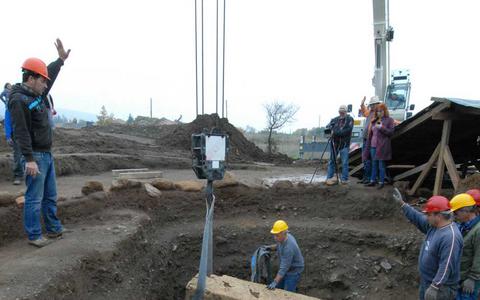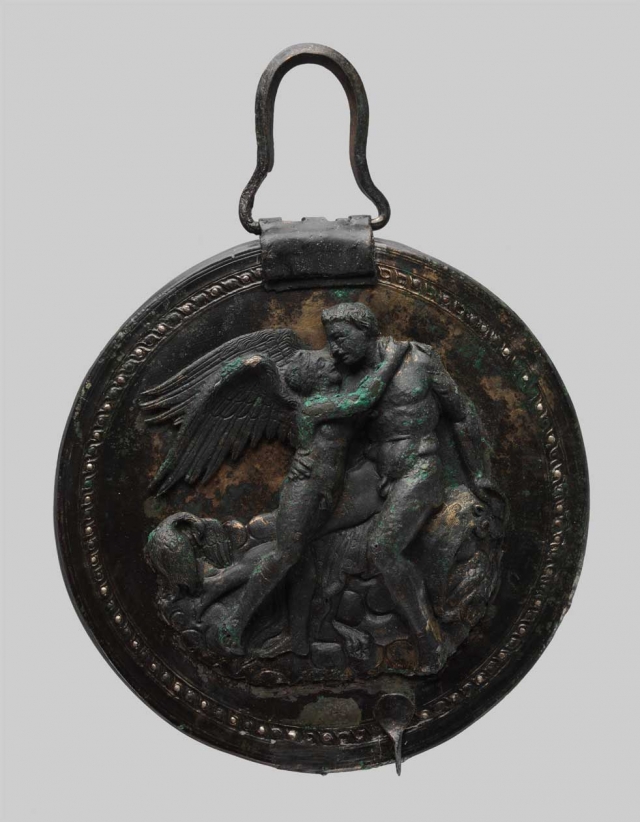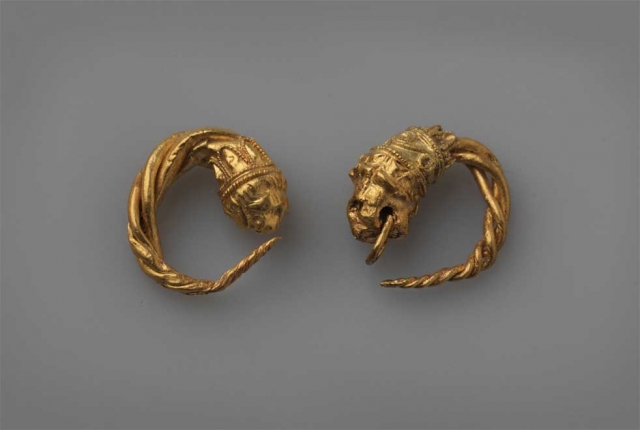collage and photos www.ethnos.gr
The magic mirror of Eros is the most striking of the many finds discovered in the Aigai necropolis during archaeological excavations in 2014. A total of 21 graves were found in two burial mounds, 6 of which have never been subject to looting.
Today, at the 28th scientific meeting dedicated to the archaeological digs in Macedonia and Thrace, the findings were presented by Angeliki Kottaridi, Director of the 17th Ephorate of Prehistoric and Classical Antiquities, including Imathia, and head of the excavation works.

Kotaridi believes the most valuable find in the first mound was recovered from the grave of a young girl from the 4th century BC. Her parents placed in her grave valuable gold earrings, jewellery, beads, and a unique mirror – the only one found in Aigai. It is a small-size work of bronze art, which according to Kotaridi is the work of a very experienced craftsman. On its lid, Eros, portrayed as a winged child, is embracing the god of passion and lust, Dionysus. The latter takes the form of a young man sitting on a panther skin spread over a rocky mound.
The remains of a funeral bed decorated with embossed ceramic tiles were found in the richest tomb, which, however, has been looted. On the tiles, Athens, wrapped in a cloak, is watching a battle between Greeks and barbarians.

The mirror of Eros
The surprise
The archaeologists found something astonishing in the second burial mound: a red wine jug depicting a banquet. It had been placed in one of the graves, dating back to the time of Alexander the Great (336-323 BC), which had never been looted.
The pitcher was sitting on the bed where the deceased was lying. His head was adorned with a gilded bronze ivy wreath. The research has shown this was a man of about 50. A small wooden table with the banquet vessels was standing north of him. In between, there was a copper bucket of fine quality for mixing the wine with water. The bucket sported rich embellishments, which highlight the extraordinary level of Macedonian metal processing.

The bucket was found lying on the floor, with remains of organic materials scattered around it. There are shreds from the bed cover fabric and the clothes of the deceased, with traces of porphýra and leather. The pieces from the wooden bed are the most abundant. The decoration on the bed front corresponds to the one on the gilded ivory beds found in the tomb of Philip II. But who was the dead man in this tomb?
This is how Angeliki Kottaridi replies: "As no epitaph was found, and the man was obviously not a member of the royal family, we are unable to name the buried person. Nevertheless, by connecting the available data we can make certain conclusions. This was an ageing man, influential enough to wear clothes dyed purple with the extremely expensive porphýra. At the same time, he was not accompanied by his weapons. If we associate this with the rare ivy wreath, we can assume the man was a priest of Dionysus or a prominent member of the troupe of the Mother of the gods (Metroon), the panhellenic deity Rhea. The existence of the latter in Aigai has been proven by an inscription from the time of the funeral," says the archaeologist.